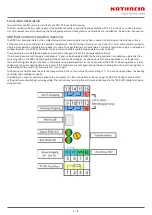
3 / 12
Functional description
Using the ESO 120/124/180 electric heaters prevents the build-up of snow, ice and frost on the antenna reflector surface, thus avoiding
faults with reception.
The control unit described in detail below performs the following tasks:
●
Automatic activation of the heating in the event of snow, ice or frost build-up
●
Automatic deactivation of the heating if the reflector temperature exceeds the set value
●
Manual activation of the heating is possible (failure of sensors/electronics, test operation in summer)
●
Operating condition display
●
Potential-free indication of faults
Brief description of controller
All electrical components are located in a light, dust and moisture-proof polycarbonate housing.
When the housing cover is opened, all components are accessible with contact protection. The terminal strip connects all the
incoming and outgoing cables (sensors, heating, power supply) to the electrical components.
Operating mode: Automatic
The electronics switch on the power circuit if:
- The ambient temperature and heating temperature fall below the set value P(+4 °C SRR; factory setting: +40 °C ELTC-21), and
- The sensor electrodes detect moisture, snow, ice or frost on the antenna surface.
The heating switches off when one of the above conditions is no longer true. However, the integral timer function can be used to set
a post heating time between 1 and 10 min (factory setting: 5 min). The post heating time thus covers a short period during which the
sensor signal drops out, perhaps due to a brief burst of sunshine or to the influence of wind on one of the sensors. Pressing “POWER
OFF” resets the post heating time.
When the load circuit is activated, the operating RGB on the SRR lights up in yellow to indicate “AUTOMATIC HEATING ON”.
Operating mode: Manual
In “MANUAL” mode, the electronics are bypassed apart from the ELTC-21 function. The load circuit is switched on and the operating
RGB on the SRR flashes yellow to indicate “MANUAL HEATING ON”
Manual mode can also be activated using the remote operation signal (5 - 30 V). In “MANUAL” mode, if a sensor has a fault for
example, the heating continues running with temperature control using the ELTC-21 heating controller.
This enables the function of the heating to be checked during the summer months.





























